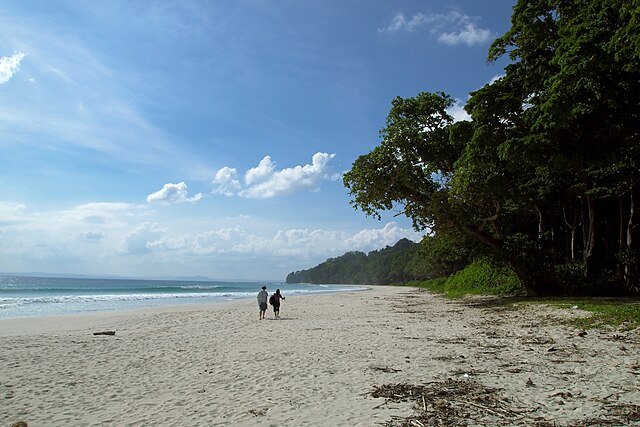India is blessed with a coastline of over 7,500 kilometres, touching the Arabian Sea, Bay of Bengal, and the Indian Ocean. Along this vast stretch lie some of the world’s most beautiful beaches—ranging from lively party hubs in Goa to pristine hidden gems in the Andaman Islands.
Whether you’re a backpacker on a budget, a family traveller, or a honeymoon couple looking for serenity, India has a beach for everyone. This guide covers India’s best beaches, things to do, budget tips, safety norms, and essential travel advice to help you plan your perfect beach holiday.
1. Baga Beach, Goa – The Party Capital
- Why Visit: Famous for nightlife, beach shacks, water sports, and vibrant markets.
- Things to Do: Parasailing, banana boat rides, dolphin cruises, Tito’s & Mambo’s nightlife, street shopping.
- Best Time: November to February.
- Budget: ₹1,500–₹3,000 per day (budget stay + food + activities).
- Safety Tip: Keep valuables safe at shacks; follow lifeguard instructions during water sports.
2. Radhanagar Beach, Havelock (Andaman & Nicobar Islands) – Asia’s Finest
- Why Visit: Often ranked among the best beaches in Asia; turquoise water, white sand, and tranquillity.
- Things to Do: Snorkelling, scuba diving, beach walks, photography.
- Best Time: October to May.
- Budget: ₹3,000–₹5,000 per day (ferry transfers + stay + food + activities).
- Safety Tip: Swimming after sunset is restricted; respect eco-rules (no plastic waste).
3. Marina Beach, Chennai – The Longest Urban Beach
- Why Visit: World’s second-longest beach, buzzing with local culture.
- Things to Do: Beach Walk, street food, horseback riding, visit nearby landmarks (Fort St. George, Kapaleeshwarar Temple).
- Best Time: November to March.
- Budget: ₹1,000–₹2,000 per day (affordable city stays + food).
- Safety Tip: Swimming is not recommended due to strong currents. Stay close to lifeguard zones.
4. Varkala Beach, Kerala – The Cliffside Beauty
- Why Visit: Famous for dramatic cliffs, Ayurveda retreats, and yoga culture.
- Things to Do: Paragliding, surfing, Ayurveda massage, cliffside cafes, temple visits.
- Best Time: October to March.
- Budget: ₹1,500–₹3,000 per day.
- Safety Tip: Use sunscreen; cliffs can be slippery during monsoons.
5. Tarkarli Beach, Maharashtra – The Scuba Diving Hub
- Why Visit: Known for crystal-clear waters and scuba diving in mainland India.
- Things to Do: Scuba diving, snorkelling, houseboat stay, dolphin spotting.
- Best Time: October to March.
- Budget: ₹1,500–₹2,500 per day (scuba diving ~₹1,500–₹2,000).
- Safety Tip: Choose certified diving operators for safety.
6. Puri Beach, Odisha – Culture Meets Coastline
- Why Visit: A mix of spirituality and sea, famous for Puri Jagannath Temple and Rath Yatra.
- Things to Do: Camel rides, handicraft shopping, temple visits, beach festivals.
- Best Time: November to February.
- Budget: ₹1,000–₹2,500 per day.
- Safety Tip: Avoid swimming during religious festivals due to crowd rush.
7. Agonda Beach, South Goa – The Quiet Escape
- Why Visit: Quieter alternative to Baga; perfect for peace seekers and honeymooners.
- Things to Do: Kayaking, dolphin watching, yoga retreats, beach huts stay.
- Best Time: November to March.
- Budget: ₹2,000–₹3,500 per day.
- Safety Tip: Limited medical facilities nearby; carry a basic first aid kit.
8. Gokarna Beaches, Karnataka – Backpacker’s Paradise
- Why Visit: Less commercialized than Goa, with stunning beaches like Om Beach, Kudle Beach, and Paradise Beach.
- Things to Do: Trekking between beaches, camping, temple visits, local seafood.
- Best Time: October to March.
- Budget: ₹1,200–₹2,500 per day.
- Safety Tip: Be cautious while trekking between rocky paths.
9. Digha Beach, West Bengal – Family-Friendly Spot
- Why Visit: Shallow waters, ideal for families and kids.
- Things to Do: Marine aquarium visit, shopping for handicrafts, seafood delicacies.
- Best Time: October to February.
- Budget: ₹1,000–₹2,000 per day.
- Safety Tip: Beware of sudden tides; stay within lifeguard-marked zones.
10. Kovalam Beach, Kerala – The Crescent Coast
- Why Visit: Famous for crescent-shaped coastline, Ayurveda spas, and lighthouse views.
- Things to Do: Surfing, catamaran rides, lighthouse climb, Ayurvedic massage.
- Best Time: September to March.
- Budget: ₹1,500–₹3,500 per day.
- Safety Tip: Rip currents can be strong—swim only in flagged areas.
Essential Travel Tips for India’s Beaches
- Budget Planning:
- Budget travellers: ₹1,000–₹2,500/day (basic stays + street food).
- Mid-range: ₹3,000–₹6,000/day (comfortable resorts, activities).
- Luxury: ₹10,000+ (5-star stays, private activities).
- Local Safety Norms:
- Always swim in designated safe zones.
- Follow lifeguard instructions and beach flag signals.
- Avoid carrying valuables to crowded beaches.
- Respect local culture—some regions prefer modest beachwear.
- Health & Environment:
- Carry sunscreen, hats, and hydration.
- Dispose waste responsibly—plastic is banned on many beaches.
- Book certified operators for water sports and diving.
- Best Time to Visit Beaches in India:
- Peak Season: November to March (pleasant weather).
- Avoid Monsoon (June–September): Rough seas, water sports suspended.
Conclusion
India’s beaches are as diverse as its culture. Whether you’re after Goa’s nightlife, Kerala’s Ayurveda charm, Andaman’s untouched beauty, or Odisha’s cultural coastline, you’ll find something that fits your taste and budget.
With the right planning, respect for local norms, and attention to safety, your Indian beach holiday can be both adventurous and memorable.
So pack your sunscreen, flip-flops, and curiosity—India’s best beaches are waiting for you!

Leave a Reply